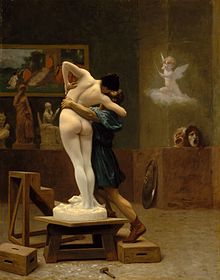Pügmalión


Pügmalión (görögül Πυγμαλίων, latinosan Pygmalion) az Ovidius Átváltozások című művében mint szobrász híressé vált legendás ciprusi személy neve. A név feltehetően a föníciai Pumayyaton király nevének görög változatán alapszik. Ovidius költeményében Pygmalion beleszeret az általa készített elefántcsont szoborba, és Aphrodité ünnepén azt kéri az istennőtől, hogy keltse életre szerelmét, amit az istennő teljesít is.
A történet alapmotívuma az évezredek során számos műalkotásban visszaköszönt, közülük az egyik legismertebb George Bernard Shaw Pygmalion című drámája, illetve ennek filmfeldolgozásai: a Pygmalion (Anthony Asquith és Leslie Howard filmje, 1938), illetve a My Fair Lady (George Cukor filmje, 1964).
További irodalom[szerkesztés]
- Essaka Joshua. (2001). Pygmalion and Galatea: The History of a Narrative in English Literature. Ashgate. (angolul)
- Kenneth Gross. (1992). The Dream of the Moving Statue. Cornell University Press. (A wide-ranging survey of 'living statues' in literature and the arts). (angolul)
- Jack Burnham. Beyond Modern Sculpture (1982). Allan Lane. (A history of 'living statues' and the fascination with automata - see the introductory chapter: "Sculpture and Automata"). (angolul)
- Ernst Buschor. Vom Sinn der griechischen Standbilder (1942). (Clear discussion of attitudes to sculptural images in classical times). (angolul)
- John J. Ciofalo. "The Art of Sex and Violence - The Sex and Violence of Art." The Self-Portraits of Francisco Goya. Cambridge University Press, 2001. (angolul)
- John J. Ciofalo. "Unveiling Goya's Rape of Galatea." Art History (December 1995), pp. 477–98. (angolul)
- Gail Marshall. (1998). Actresses on the Victorian Stage: Feminine Performance and the Galatea Myth. Cambridge University Press. (angolul)
- Alexandra K. Wettlaufer. (2001). Pen Vs. Paintbrush: Girodet, Balzac, and the Myth of Pygmalion in Post-Revolutionary France. Palgrave Macmillan. (angolul)
- Danahay, Martin A. (1994) "Mirrors of Masculine Desire: Narcissus and Pygmalion in Victorian Representation". Victorian Poetry, No. 32, 1994: pages 35–53. (angolul)
- Edward A. Shanken. (2005) “Hot 2 Bot: Pygmalion’s Lust, the Maharal’s Fear, and the Cyborg Future of Art,” Technoetic Arts 3:1: 43-55. (angolul)
- (2005). Almost Human: Puppets, Dolls and Robots in Contemporary Art, Hunterdon Museum of Art, Clinton, NJ. (Catalogue for a group exhibition Mar 20 - Jun 12 2005) (angolul)
- Mathias Mayer (Hrsg.): Pygmalion: die Geschichte des Mythos in der abendländischen Kultur, Rombach, Freiburg im Breisgau 1997, ISBN 3-7930-9141-4 (németül)
- Andreas Blühm: Pygmalion. Die Ikonographie eines Künstlermythos zwischen 1500 und 1900, Lang, Frankfurt am Main u.a. 1988, Reihe: Europäische Hochschulschriften, Reihe 28: Kunstgeschichte, Band 90, ISBN 3-631-40797-1; zugl. Berlin, Freie Univ., Diss., 1987 (németül)
- Annegret Dinter: Der Pygmalion-Stoff in der europäischen Literatur. Rezeption einer Ovid-Fabel., Studien zum Fortwirken der Antike; Bd. 11, Winter, Heidelberg 1979, ISBN 3-533-02775-9; Zugl.: Bonn, Univ., Philos. Fak., Diss., 1977 (németül)
- Birgitt Werner: Das pygmalion-Motiv in der Aufklärung (PDF), In: Wolf-Dieter (Hg): Bildung und Gesellschaft im Wandel, Oldenburg 1999, Festschrift (németül)
További információk[szerkesztés]
A Wikimédia Commons tartalmaz Pygmalion témájú médiaállományokat.
- Herzl Tivadar Pygmalion című elbeszélése az angol nyelvű Wikiforrásban.
- Metamorphoses versének angol fordítása
- a 243-297 sorok az Átváltozások (Ovidius) latin eredetijében (Ad Fontes Academy The latin library)
- Téli rege, Shakespeare hivatkozása a Pigmalion történetre Shakespeare and the Uses of Antiquity: An Introductory Essay By Charles Martindale Published by Routledge, 1994 ISBN 0-415-10426-2, 9780415104265 (angolul)


